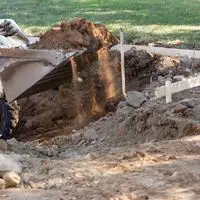Grading yard away from house. If you need to grade a yard away from your house, follow stepwise procedures to ensure proper grading. The prime purpose of yard grading is to ensure the water flows away from your home’s foundation.
Grading also provides a healthy appearance to the garden. Yard grading May seem to be complicated, but it’s quite a handy job.
Grading yard away from house (Guidelines)
Minimum slope required to prevent drainage problems
- 2 to 3 inches for every 10 feet away from home
- Or about 2 percent
Maximum slope required to prevent erosion problems
- 12 inches for every 4 feet
- Or about 25 percent
Procedure
Let’s begin the yard grading by observing the slope of the yard. Find which way the yard is sloped. As you are here, it means you already know where your problem areas lie.
Let’s get started
Indicate the high and low yard points
Take a can of spray and mark the high and low areas. That will act as visual indication points.
-
High Point
The high point lies where the water starts draining in the wrong direction.
This point directs the water flow towards your house.
-
Low Point
The low point lies near the foundation. It’s that spot where the water.
Establish a level grade line
Find the Rise” and the “Run” of the land.
The rise and run provide a level grade line. This line indicates how much grading is needed.
“Run”
It is the measure of horizontal distance comprising how far the highest point from the lowest point is.
Your run must be a straight line.
Procedure
- Take two stakes and place one at the highest point and another at the lowest.
- Now connect them with a tight string.
- Attach them with a leveled spring.
- Now Measure the length of the string.
- Note down the value. That is going to be your “run.”
“Rise”
It is the vertical distance, comprising inches/feet that the ground is sloping, from the high point towards the low point.
Procedure
- To find the yard rise, measure the stake.
- Measure it at the low point.
- Note down the value, it’s the rise of the yard.
You can also opt for a laser distance meter to measure length, volume, and area. It measures a distance of up to 65 feet.
Purchase Topsoil (dirt)
- After finding the points, purchase dirt that needs to be dumped down into the low point, to make a high point.
- You can get a few bags of topsoil from the hardware store.
Form in which topsoil comes
- You can get Topsoil for 40 lb per bag
Cost of Topsoil
- $2.00/ bag
Dumping Topsoil at the Low Point
- Take a Shovel and place the dirt into a wheelbarrow.
- After that, dump it at the yard’s low point.
- To reverse the grade, dump a big old pile of dirt against the foundation.
- Place enough dirt so that the low point becomes the high point.
- Once the dirt is added, Use a rake’s backsides to level the ground.
- Slowly and gradually smooth the topsoil.
Pank Down the Dirt
- Now plank the yard by placing plywood, to make sure you are filling
- the uneven surfaces.
- Again check the grade by using the stakes and leveled string.
- If everything checks out, smooth it out with a rake and then water it to make the soil compact.
- It is recommended by many landscapers, planting the grass seed immediately after grading the yard prevents erosion. That is because the roots of the grass bind with the soil.
Conclusion
If you need to Grading yard away from house, this simple procedure will help you a lot. Try it out and share your experience.
Related Guides

